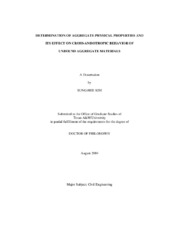| dc.contributor.advisor | Little, Dallas N. | |
| dc.creator | Kim, Sung-Hee | |
| dc.date.accessioned | 2005-11-01T15:50:53Z | |
| dc.date.available | 2005-11-01T15:50:53Z | |
| dc.date.created | 2004-08 | |
| dc.date.issued | 2005-11-01 | |
| dc.identifier.uri | https://hdl.handle.net/1969.1/2745 | |
| dc.description.abstract | Work done by several researchers reveals that unbound aggregate materials show nonlinear cross-anisotropic behavior. The incorporation of cross-anisotropic properties significantly improves the predictions of stress distribution by reducing tensile stresses computed within granular layers. Existing pavement analysis and design approaches, however, generally assume the pavement structure to be linear isotropic layered system. This assumption is motivated by the difficulties in determining cross-anisotropic resilient material properties from laboratory experiments and lack of pavement anisotropic analysis programs.
Recently, the International Center for Aggregates Research (ICAR) developed a methodology to characterize unbound aggregate layers by considering stress-sensitivity and nonlinear cross-anisotropy. The ICAR model requires nine coefficients to account for stress-sensitivity and anisotropy of vertical, horizontal, and shear moduli. Unfortunately, ICAR testing protocol is time-consuming and expensive to perform and certainly do not lend themselves to routine testing. Since it is important to be able to consider the stress-sensitive and anisotropic nature of unbound granular materials, a simple procedure was proposed by accounting for the effects of aggregate gradation and shape properties in predicting the cross-anisotropic modular ratio of unbound granular materials. Variable confining pressure type repeated load triaxial tests were performed on six aggregate sources with three different gradations and three different moisture contents. The experimental results were analyzed within the framework of nonlinear cross-anisotropic elastic model in order to determine the model coefficients. Image analysis techniques were utilized to measure aggregate shape properties. The gradation and shape properties were fitted using a cumulative distribution function and nonlinear regression analysis, which is capable of capturing the complete distribution of these properties. The experimental and analytical results indicate that the vertical resilient modulus is greater than the horizontal resilient modulus and that aggregate physical properties significantly affect the anisotropic resilient behavior.
Based on finite element analysis, the anisotropic resilient behavior has substantial effect on the critical pavement responses. Thus, it is extremely valuable to approximate the degree of cross-anisotropy in unbound aggregates and to use it as input in the pavement analysis programs to adequately model unbound aggregate bases for pavement design and analysis. | en |
| dc.format.extent | 1065811 bytes | en |
| dc.format.medium | electronic | en |
| dc.format.mimetype | application/pdf | |
| dc.language.iso | en_US | |
| dc.publisher | Texas A&M University | |
| dc.subject | Cross-Anisotropy | en |
| dc.subject | Unbound Aggregate Base | en |
| dc.subject | Pavement Design | en |
| dc.subject | Image Analysis | en |
| dc.title | Determination of aggregate physical properties and its effects on cross-anisotropic behavior of unbound aggregate materials | en |
| dc.type | Book | en |
| dc.type | Thesis | en |
| thesis.degree.department | Civil Engineering | en |
| thesis.degree.discipline | Civil Engineering | en |
| thesis.degree.grantor | Texas A&M University | en |
| thesis.degree.name | Doctor of Philosophy | en |
| thesis.degree.level | Doctoral | en |
| dc.contributor.committeeMember | Mathewson, Christopher C. | |
| dc.contributor.committeeMember | Masad, Eyad | |
| dc.contributor.committeeMember | Roesset, Jose M. | |
| dc.contributor.committeeMember | Lytton, Robert L. | |
| dc.type.genre | Electronic Dissertation | en |
| dc.type.material | text | en |
| dc.format.digitalOrigin | born digital | en |


